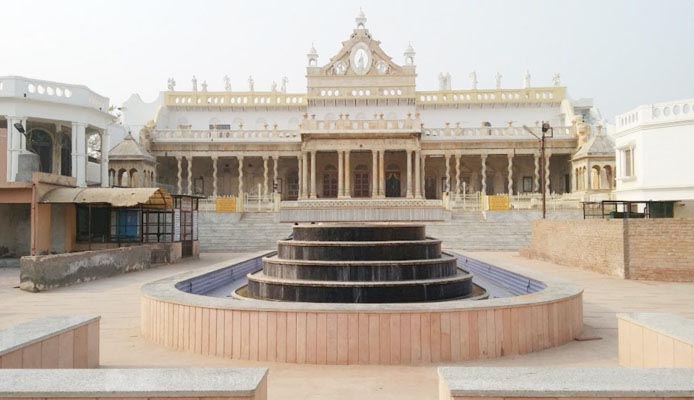Shahji Temple

Information of Shahji Temple, Vrindavan, Mathura, Uttar Pradesh
Shahji Temple is regarded as one of the popular temples in Vrindavan. It is also known as twisted pillar temple because, the columns in the temple are created from lovely white warped marble. The temple is unique and has gained significant admiration owing to its superb construction. Shahji Temple is devoted to lord Radha-Krishna. The temple was created by wealthy merchants of Lukhnow named Shah Kundan Lal and Shah Fundal Lal in the year 1876. Apart from religious place, Shahji Temple is also an important tourist destination in Vrindavan.
Shahji Temple Religious Significance
Shahji Temple is a very creative temple. The deity reigning and consecrating the temple has its eternal massage of religious halt, marking the gallant end of human life. Shahji Temple possesses an amazing Durbar Hall of Radha Raman which is also known as Vasanti Kamra. The room is completely designed with yellow colour. Furthermore, there are several beautiful Belgium chandeliers in this room. Shahji Temple is opened for devotees every day, but the Durbar Hall is accessed by devotees in only two times in a year. The first is during Basant Panchami. On this occasion, the hall is opened for about 2 days. The second is through Julan Yatra. On these occasions, the idols in the temple are brought in Durbar Hall and are decorated and worshipped with love. Thousands of devotees visit Shahji Temple on these festive times.
Shahji Temple Mythology & History
The theme which is represented in Shahji Temple, dates back to the era of Mathura figurine. The temple has been rendered with remarkable delicacy and vivacity. In Shahji Temple, attempt has been made in order to imply Radha and Krishna. Shahji Temple demonstrates the male and female relationships with respect to love between Radha and Krishna. This fictional tradition of Radha and Krishna dates back from traditional times when memorable song Gita Govinda was regarded as a key breakthrough. The sections in Shahji Temple apparently suggest that the creators of the temple were no general craftsman.
There is also a quite interesting mythology regarding the creators of Shahji Temple. According to legend, when the creators died, they did not desired their body to be carried on shoulders which usually occur in Hindu tradition. Hence, they agreed that after death, their bodies were to be drawn by the soil of Vrindavan. They also did not desired to burn their bodies, because the smoke of their burning bodies will then leave the Vrindavan area. Moreover, if the ashes of their body would drown to Yamuna River, they would finally be carried away from Vrindavan. Hence, there is tomb of the two creators near the gateway of the temple. They had pictured themselves etched in the ground of the temple. This was done so that devotees walk over them while entering the temple and put the soil of Vrindavan on them.
Shahji Temple Architectural Significance
The architecture of Shahji Temple is completely different than normal design of a Hindu temple. Shahji Temple is a mixture of Greek, Mughal and Hindu architectural style. The complete temple is created by Italian marble. The large terraces of Shahji Temple are supported by curved pillars which are moulded from one singular piece of Italian marble. Every pillar of the temple is about 13 feet tall with 35 inch width. The pillars of Shahji Temple is the core attraction which have supported the huge structure of the building. There are also various outstanding paintings in the temple which embellish the inner design.
- Andhra Pradesh Temples
- Assam Temples
- Bihar Temples
- New Delhi Temples
- Goa Temples
- Gujarat Temples
- Jammu and Kashmir Temples
- Karnataka Temples
- Kerala Temples
- Madhya Pradesh Temples
- Maharashtra Temples
- Odisha Temples
- Punjab Temples
- Rajasthan Temples
- Sikkim Temples
- Tamil Nadu Temples
- Telangana Temples
- Uttar Pradesh Temples
- Uttarakhand Temples
- West Bengal Temples